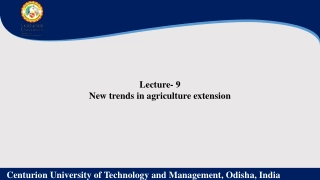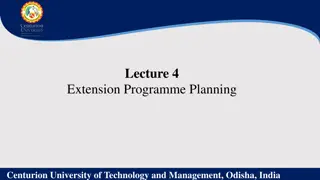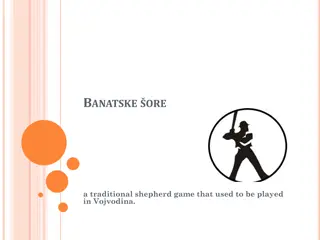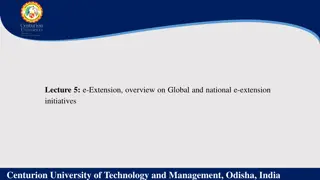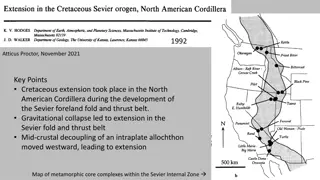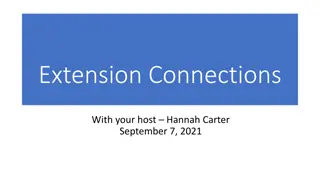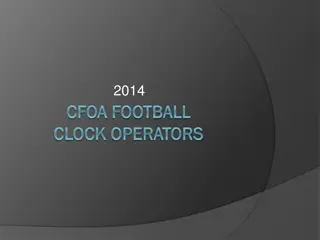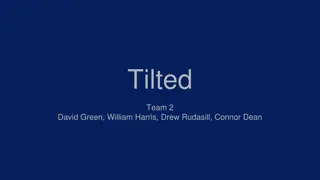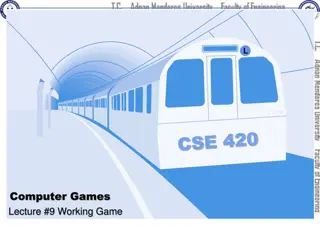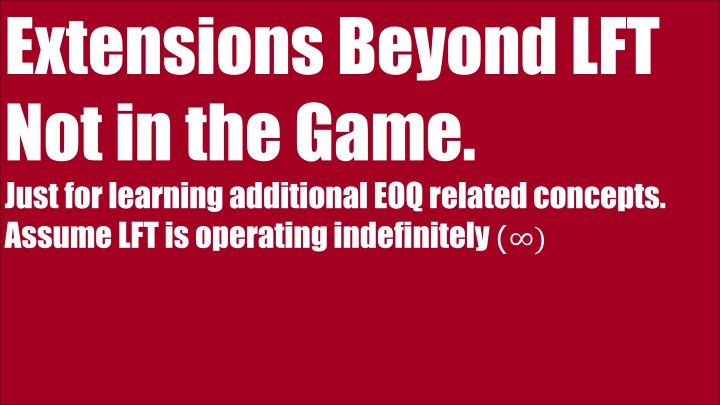
Advanced Concepts in EOQ Models - Littlefield Technologies Extensions
Explore extensions of the EOQ model with practical examples in the context of Littlefield Technologies, including periodic inventory systems and the impact of demand changes on EOQ and total costs.
Download Presentation

Please find below an Image/Link to download the presentation.
The content on the website is provided AS IS for your information and personal use only. It may not be sold, licensed, or shared on other websites without obtaining consent from the author. If you encounter any issues during the download, it is possible that the publisher has removed the file from their server.
You are allowed to download the files provided on this website for personal or commercial use, subject to the condition that they are used lawfully. All files are the property of their respective owners.
The content on the website is provided AS IS for your information and personal use only. It may not be sold, licensed, or shared on other websites without obtaining consent from the author.
E N D
Presentation Transcript
Extensions Beyond LFT Not in the Game. Just for learning additional EOQ related concepts. Assume LFT is operating indefinitely ( )
Problem-1. Periodic Inventory System In this section, we go through some extensions of the Littlefield assumptions and basic EOQ model. These concepts may not exist in the LittleField game. They are general inventory concepts, but we discuss them in the context of the LittleField Technologies. Problem-1. Suppose you have decided to switch to the Periodic Inventory System. Assume that you decide to order every 30 days. That is an order size of 15(30)= 450 product (60*450 kits per order). We assume all months are 30 days and a year is 12.17 months. a) Compute the cycle inventory Icycle = Q/2 = 450/2 =225. b) Compute the number of cycles (assume LFT continues for many years). # of cycles = 5475/450 = 12.17 c) Compute the length of a cycle. Cycle length = 30 days. Extensions of EOQ Model in LittleField Technologies Game Environment, Ardavan Asef-Vaziri 2
Periodic Inventory d) Compute flow time T= 30/2 = 15. Alternatively, T=I/R = 225/5475 = 0.041095890 year or 225/15= 15 days. e) Compute inventory turns InvTurns = 5475/225 = 24.33 InvTurns = 1/T = 1/15??!! 1/15 or 24.33? 1/15 is in days, 24.33 is over a year (1/15)*365= 24.33. f) Compute the total inventory costs. TC = OC + CC = SD/Q + HQ/2 TC = 1000*5475/450 + 120*450/2 TC = 12166.7 + 27000 = 39166.7 Extensions of EOQ Model in LittleField Technologies Game Environment, Ardavan Asef-Vaziri 3
Other Than EOQ System Perpetual Periodic Percentage D H 120 120 S Q Icycle 151 225 49% FT TC 5475 5475 1000 1000 302 450 49% 10.067 15 49% 36249 39167 8% Problem-2. Return to continuous inventory system. Suppose kits are delivered in boxes of 400 products. That is boxes of 24000 kits. What is the impact on the total cost. The current EOQ with all the decimal points is 311.9829. TC(EOQ) = 1000*5475/302.0761 + 120*302.0761 = 18124.57 + 18124.57 = 36249.14. TC(400) = 1000*5475/400 + 120*400/2 = 13687.5 + 24000 = 37687.5. Ordering cost goes down, because we order in larger quantities. Carrying cost goes down, because we carry more inventory. Total cost goes up because we order other than EOQ. Q2/Q1 = (400-302)/302 = 32.5% TC2/TC1 = (37687.5-36249.14)/36249.14 = 4% Q: 32.5% TC: 4% Extensions of EOQ Model in LittleField Technologies Game Environment, Ardavan Asef-Vaziri 4
Square Root Effect- Demand Doubled Problem -3. Suppose the following parameters remain the same. S=$1000, C=$600, h=0.2, H = hC = 0.2(600) = $120. However, assume the demand is doubled, and we have enough capacity to accept the incoming demand. D = R = 2(5475) = 11680. Compute the impact on EOQ and TC. 2 ???? 1000 120 2 ? ???? 1000 120 EOQOld = EOQNew = 2 ? ???? 1000 120 EOQNew EOQOld =427.2 302 EOQNew EOQOld= = 1.41 = 2 = 2 = 1.41 2 ???? 1000 120 If demand is doubled, EOQ decreases by SQRT(2) Extensions of EOQ Model in LittleField Technologies Game Environment, Ardavan Asef-Vaziri 5
Square Root Effect- Changes in EOQ The same is true for S. For example, if S is reduced to $250, that is divided by 4. Then EOQ is halved. 2 5475 ??? 120 EOQ = = 151. That is 50% of 302. If H is reduced to 1/4 of the original value, EOQ is doubled. 2 5475 1000 ?? EOQ = = 604 that is twice 302. Average Inventory (I) when we do not have safety stock is referred to as Cycle Inventory (Icycle). Cycle Inventory (Icycle) when we order Q is Q/2, and for EOQ is . 2?? ? 2 = I = EOQ/2 ? =??? 2?? 4?= ?? 2? 2 = Extensions of EOQ Model in LittleField Technologies Game Environment, Ardavan Asef-Vaziri 6
Square Root Effect- Changes in EOQ, Icycle, and Flow Time Formula Proof for Flow Time Under EOQ If D (or R) is multiplied by K, EOQ is multiplied by SQRT(K). If S is multiplied by K, EOQ is multiplied by SQRT(K). If H is multiplied by K, EOQ is divided by SQRT(K). The same can be said about Cycle inventory and In-storage flow time. What about annual inventory cost (TC=OC+CC). Again, we assume that the operations continues for several years- That is a basic assumption in EOQ model. Total cost of any Q? TCQ = OCQ + CCQ TCQ = SR/Q + HQ/2 This is a correct formula everywhere, including at EOQ, but we can simplify it for EOQ. At EOQ, we have OCEOQ = CCEOQ Extensions of EOQ Model in LittleField Technologies Game Environment, Ardavan Asef-Vaziri 7
Total Inventory Cost Formula at EOQ, and Inventory Cost Per unit . TCEOQ = 2CCEOQ = 2(H*EOQ/2) TCEOQ = H*EOQ H22RS H 2RS H= = 2RSH TCEOQ= H ?????= ????=SQRT(2*5475*1000*120) = 36249.14. If D (or R) is multiplied by K, TCEOQ is multiplied by SQRT(K). If S is multiplied by K, TCEOQ is multiplied by SQRT(K). If H is multiplied by K, TCEOQ is multiplied by SQRT(K). Compute average inventory cost per unit of product = TC/D or TC/R since we assume D=R TC/R = 36249.14/5475 = 6.62 Compute % of inventory cost in cost of goods sold excluding fixed costs = 6.62/600 1.1% Extensions of EOQ Model in LittleField Technologies Game Environment, Ardavan Asef-Vaziri 8
Centralization vs. Decentralization Orderong Four LFT plants. Order individually or collectively. D =5475 and H = $120 per product per year remain the same. S = $800 fixed, plus $200 per plant. That is S = $800+$200=$1000 if each warehouse order independently. S=800+200+200 = 1200 if two plants order together. S = 800+200+200+200+200 = $1600. When two or more plants order together, S goes up since the truck travel time in a route to more than one warehouses is longer than a trip to a single warehouse. Currently each plant orders independently. We already have the followings for each warehouse. EOQ = 302 Cycle inventory (Icycle) = 302/2 = 151 Icycle for 4 warehouses = 4(151) = 604. Demand = 5475 per year or 15 per day Cycle length = 302/15 = 20.133 days In-Storage Flow time = 20.133/2 = 10.1 days (Alternatively, I/R = 151/15 = 10.1 days Extensions of EOQ Model in LittleField Technologies Game Environment, Ardavan Asef-Vaziri 9
Centralization vs. Decentralization Orderong a) Compare Cycle inventory for Centralized vs Decentralized. Demand for 4 plants = 4(5475), and EOQ if 4 plants order together 2(4 5475)(1800) 120 =764.2 ??? = The total cycle inventory across all four outlets equals 382, compared to 604. A (604-382)/604 = 37% b) Compare total inventory cost Centralized vs Decentralized. TC-Centralized = SQRT(2*4*5475*1600*120) = 91704. TC-Decentralized (already computed for one plant) = 36249. TC-Decentralized 4 plant = 4(36249) = 144996. A (144996- 91704)/144996 = 37% cost reduction Extensions of EOQ Model in LittleField Technologies Game Environment, Ardavan Asef-Vaziri 10
Ordering Interval, Inventory Cycle, Flow Time c) Compute the ordering interval in decentralized and centralized systems. Decentralized R/Dy = 15/Dy Centralized R/Dy = 4(15) = 60/Dy Decentralized = 302/15 = 20.14 days Centralized = 790/64 = 12.74 days d) Compute the average in-storage flow time 20.14/2 = 10.07 days 12.74/2 = 6.37 days Alternatively- Using The Little s Law RT = I T= R/I 15T= 151 T = 151/15 days 60T= 382 T = 382/60 days Extensions of EOQ Model in LittleField Technologies Game Environment, Ardavan Asef-Vaziri 11
Three Alternatives System Indivisually Pairs All Percentage # of Partners 1 2 4 D H 120 120 120 S Q Icycle 151.04 233.99 382.10 Cycle Length 20.14 15.60 12.74 FT TC IcycleAll 604.15 467.97 382.10 37% TCAll 144997 112314 91704 37% 5475 10950 21900 1000 1200 1600 302.08 467.97 764.20 10.07 7.80 6.37 37% 36249 56157 91704 Extensions of EOQ Model in LittleField Technologies Game Environment, Ardavan Asef-Vaziri 12
How to Reduce EOQ To reduce EOQ we may R, S, H Rand H are out of question. ReduceS. IT&IS can help in reduction of fixed costs. It can cut operational costs for buyers and suppliers. Suppose you could have hired an IT/IS consultant to reduce S in the game such that the EOQ is lowered to the number of kits needed for 100 contact. To what value do the consultant company needs to lower S? 2 RS = EOQ H 2 5475 S 120 120 10000 2(5475) EOQ = S= 2 5475 S 120 S = $110 = 100 = 10000 Extensions of EOQ Model in LittleField Technologies Game Environment, Ardavan Asef-Vaziri 13
How to Reduce Inventory Centralize EOQ increases as the square route of demand and the square route of the ordering cost. Breakdown S on a larger order quantity. Commonality, modularization and standardization is another type of Centralization. Postponement, Delayed Differentiation. Extensions of EOQ Model in LittleField Technologies Game Environment, Ardavan Asef-Vaziri 14

